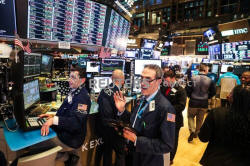Futures slide at start of year on concerns of global
slowdown
 Send a link to a friend
Send a link to a friend
 [January 02, 2019]
By Shreyashi Sanyal [January 02, 2019]
By Shreyashi Sanyal
(Reuters) - U.S. stock index futures sank
on Wednesday, offering no respite as Wall Street comes off its worst
year in a decade, as weak data in Asia and Europe confirmed fears of a
global economic slowdown, while the U.S. government shutdown dragged on.
S&P 500 e-minis <ESc1> and Dow e-minis <1YMc1> were down 1.2 percent at
7:16 a.m. ET, while Nasdaq 100 e-minis <NQc1> slid 1.9 percent.
China's factory activity contracted for the first time in 19 months in
December, hit by the Sino-U.S. trade war, the private Caixin/Markit PMI
survey showed, with the weakness spilling over to other Asian economies.
While Euro zone manufacturing activity barely avoided contraction, a
drop for the fifth month took the reading to its lowest since February
2016.

The grim readings come ahead of the closely watched U.S. manufacturing
survey on Thursday, payrolls data on Friday and the U.S. earnings season
later this month, which is expected to show corporate profit shrunk in
the October-December quarter.
All 29 of the 30 Dow Jones Industrial Average <.DJI> that were trading
premarket were lower, with the blue-chip index set to tumble more than
350 points at the open.
The high-growth FAANGS — Facebook Inc <FB.O>, Apple Inc <AAPL.O>,
Amazon.com Inc <AMZN.O>, Netflix Inc <NFLX.O> and Alphabet Inc <GOOGL.O>
— were down between 1.4 percent and 2.1 percent.
"Investors are clearly concerned about the growth in 2019 and the lack
of confidence is keeping them on the sidelines or they are feeling safer
by parking their capital in risk-off assets," said Naeem Aslam, chief
market analyst at Think Markets UK Ltd in London.
A low appetite for risk sparked demand for U.S. Treasuries, with yields
on ten-year debt <US10YT=RR> diving to a 12-month low of 2.6470 percent.
The spread between two- and 10-year yields <US2US10=TWEB> in turn shrunk
to the smallest since 2007, a flattening that has been a portent of
recessions in the past.
[to top of second column] |

Traders work on the floor of the New York Stock Exchange (NYSE) in
New York, U.S., December 28, 2018. REUTERS/Jeenah Moon

Last year, the Dow, S&P 500 <.SPX> and Nasdaq <.IXIC> recorded their
biggest one-year percentage declines since 2008, and many of the
concerns, mainly to do with a slowing economy, have carried over into
this year.
One of them has been the trade dispute between the United States and
China, which accounts for a sizeable portion of revenue for many U.S.
companies. Investors are keenly tuned into updates on the ongoing talks
as a March 1 tariff-ceasefire deadline nears.
While U.S. President Donald Trump said last weekend that talks were progressing
well, many analysts doubt the two countries can bridge their differences and
reach a comprehensive trade deal in so short a negotiating window.
Meanwhile, the U.S. Congress is set to reconvene with no signs of a workable
plan to end a 12-day-old partial shutdown and Trump not budging on his demand
for $5 billion to fund a border wall. A Democrat plan to approve a two-part
spending package does not include these funds.
While the shutdown is expected to have little effect on economic or corporate
activity, the longer it lasts, the more it will weigh on an already weak
investor sentiment.
(Reporting by Shreyashi Sanyal in Bengaluru; Additional reporting by Medha
Singh; Editing by Shounak Dasgupta)
[© 2019 Thomson Reuters. All rights
reserved.] Copyright 2019 Reuters. All rights reserved. This material may not be published,
broadcast, rewritten or redistributed.
Thompson Reuters is solely responsible for this content.
 |